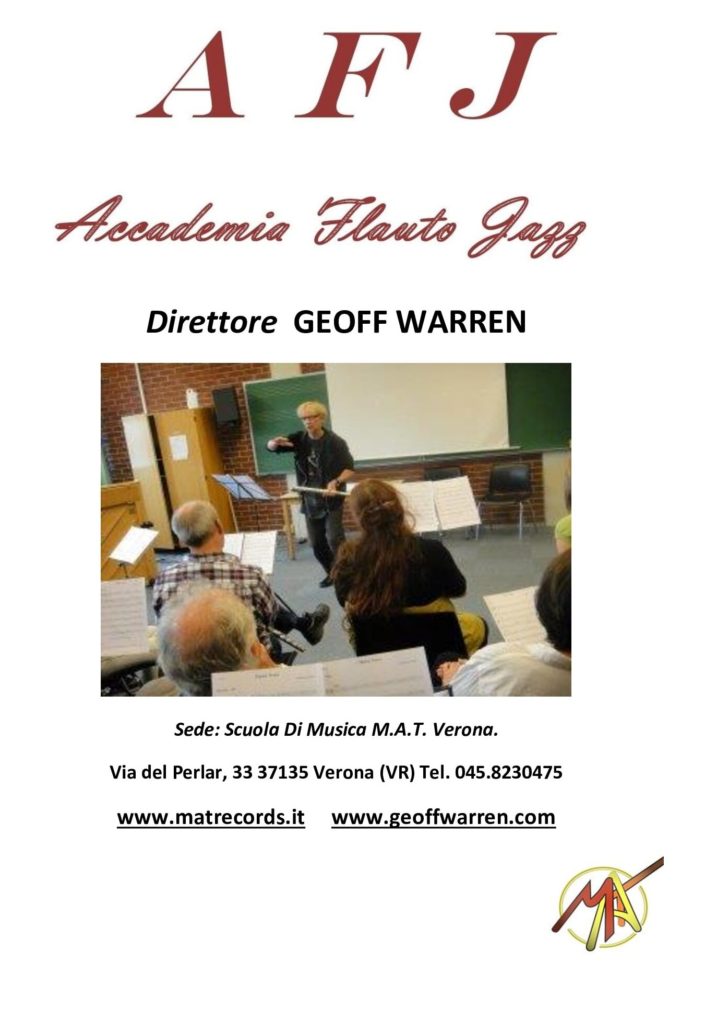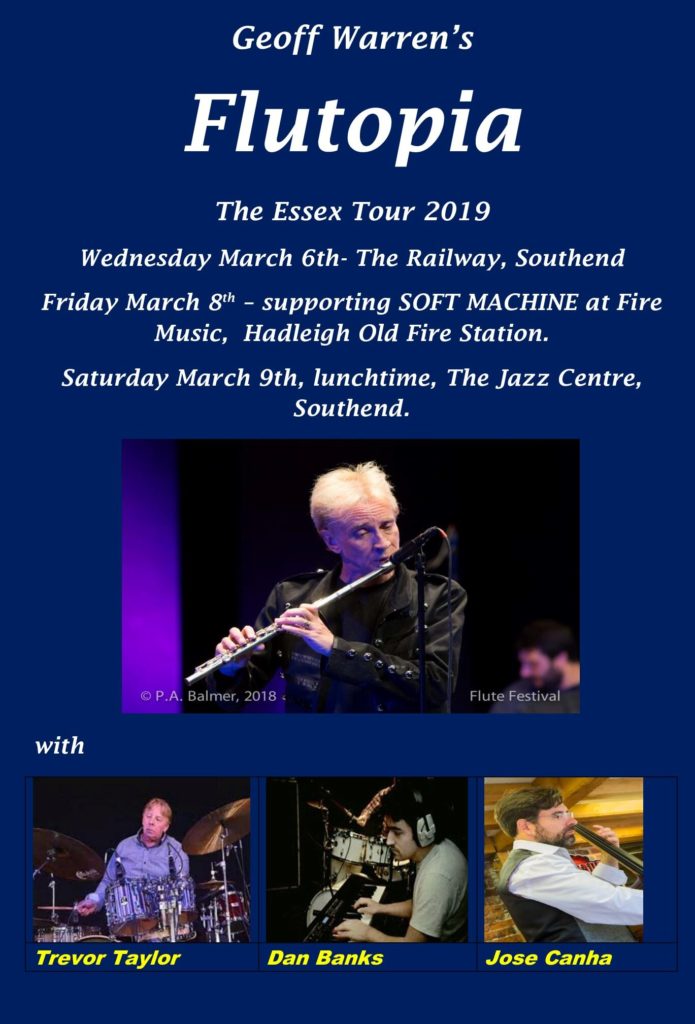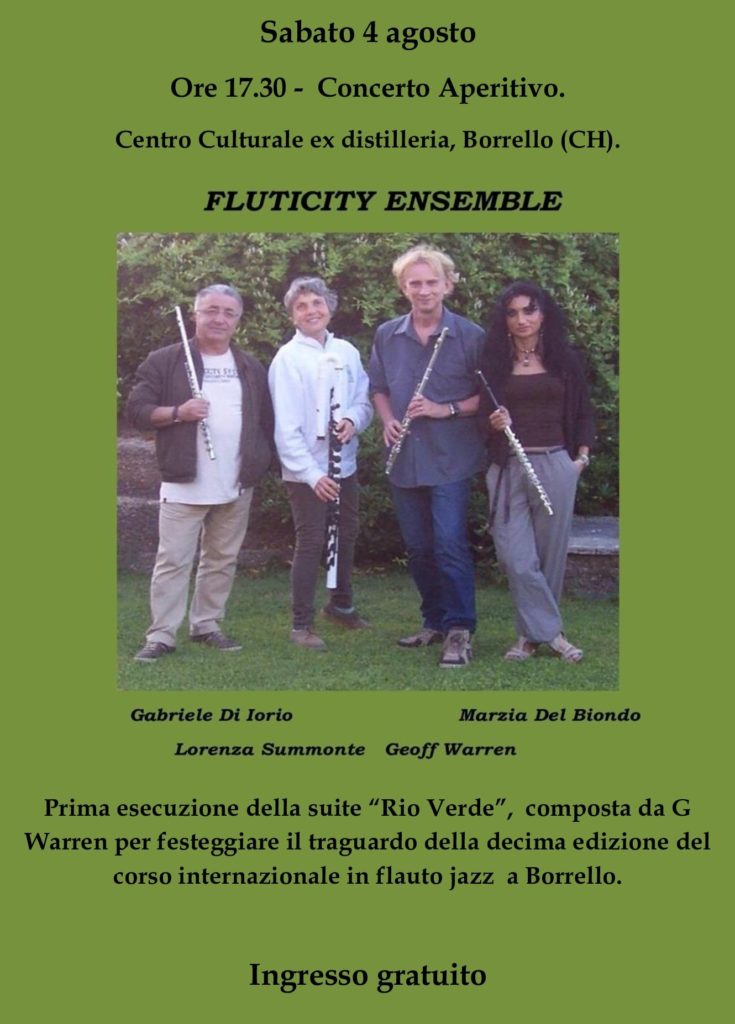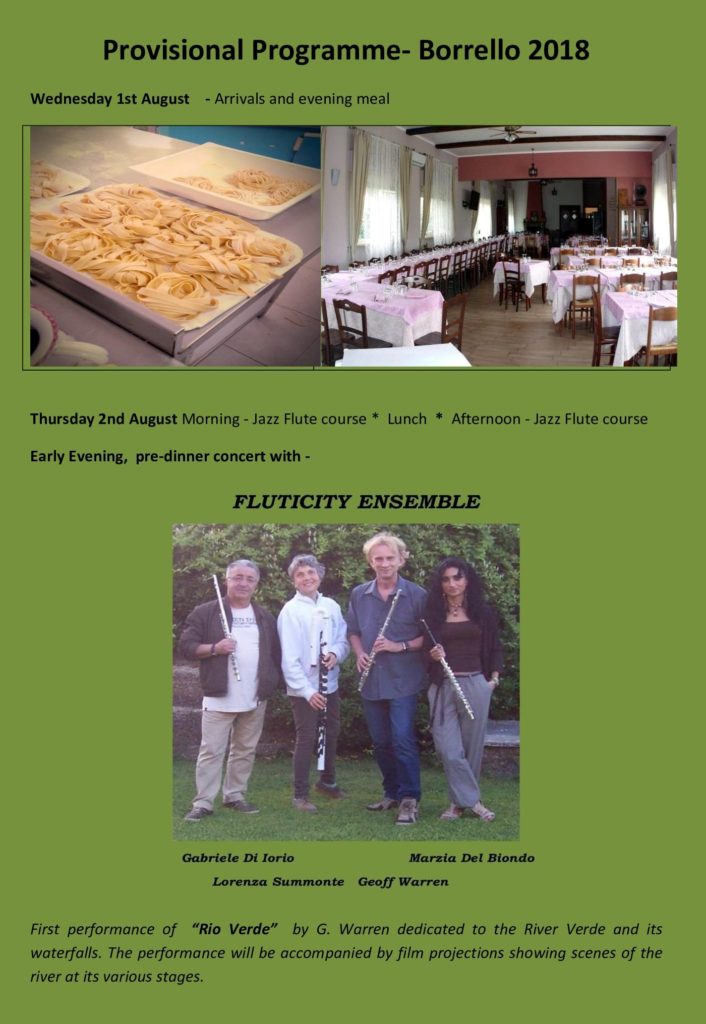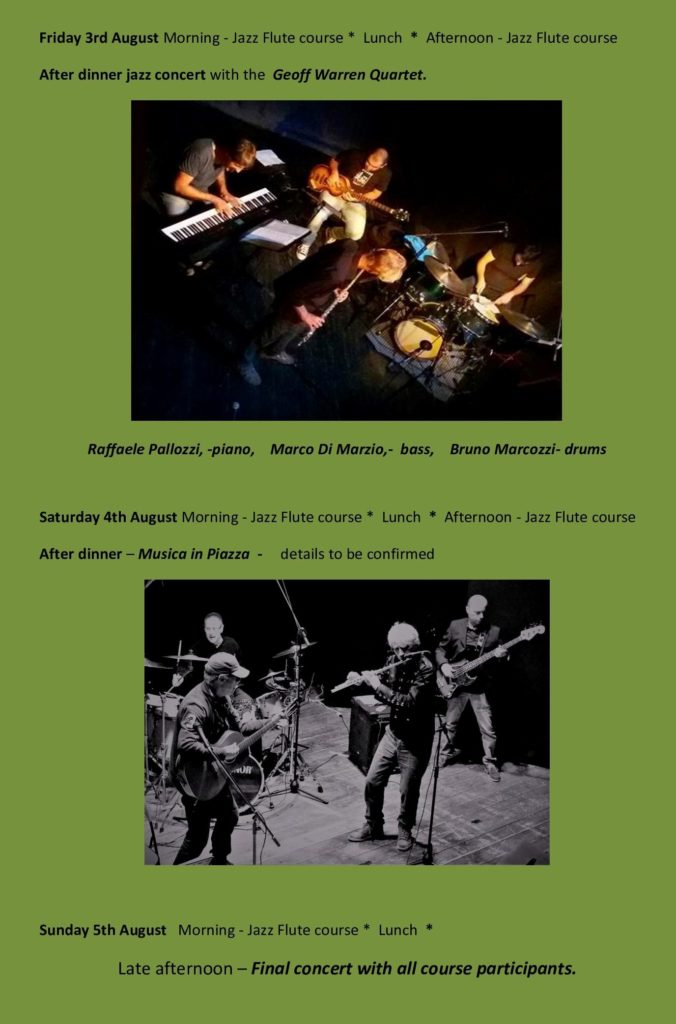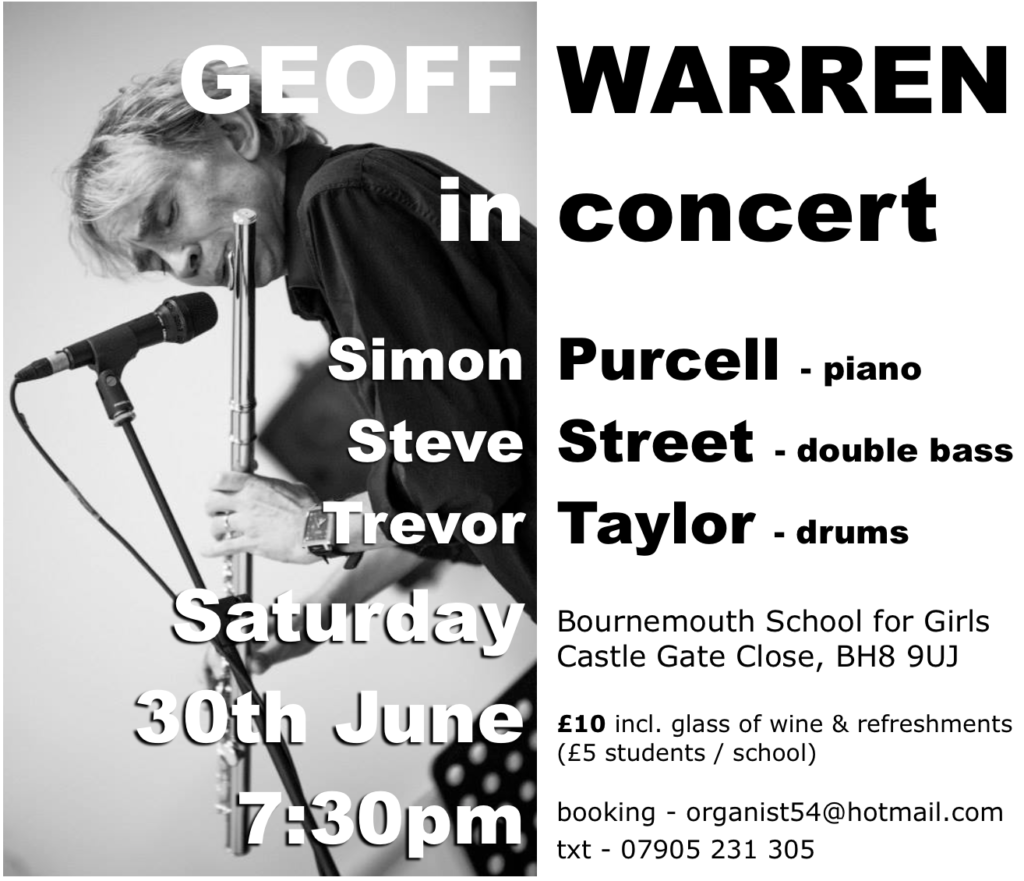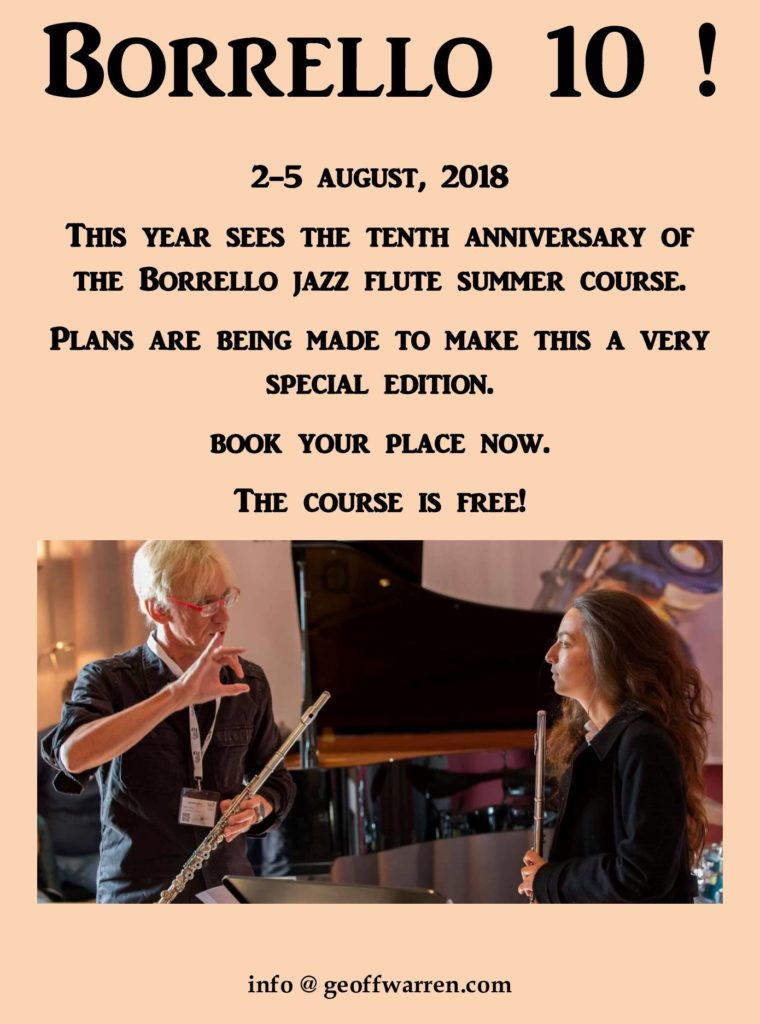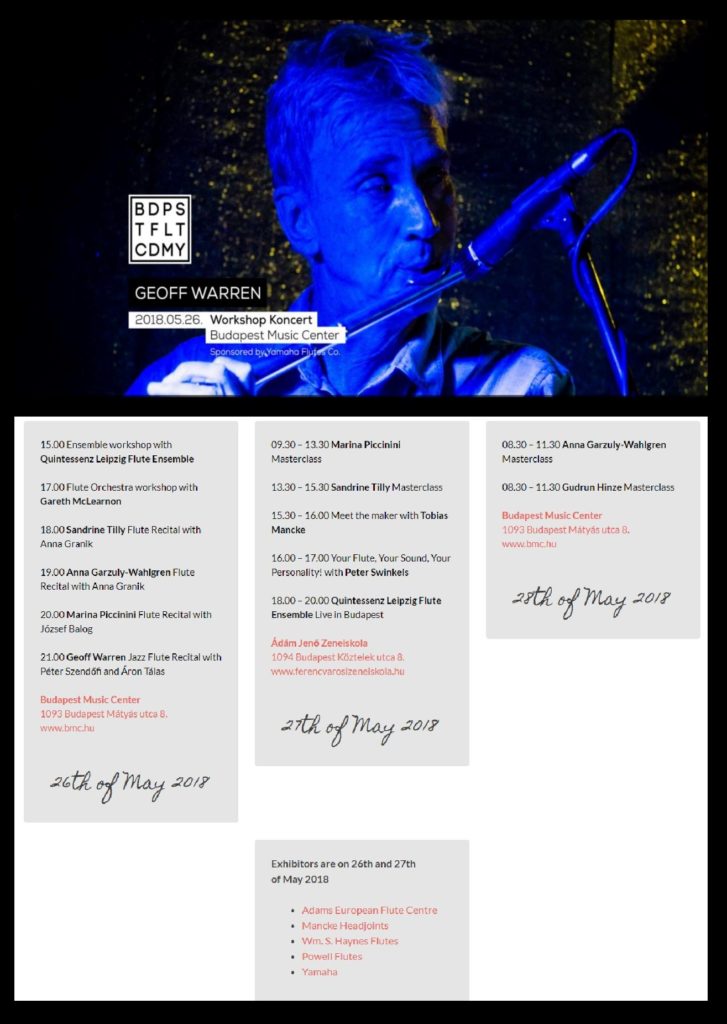Uncategorized: Clemente Bonati funky funky jazz geoff warren Geoff Warren Quartet groove Harry Warren jazz education jazz flute summer school jazz flutemusic LAUREA IN FLAUTO JAZZ Marco Di Marzio MatRecords skype jazz flute lessons TUTU Records yamaha
by admin
leave a comment
The latest chapter in my Autobiographical Blog (click above left to see the full story.)
Composing and…Publishers
I think I wanted to be a composer even before I wanted to be a performing musician. From the age of about 12, I was buying books of music manuscript paper and lovingly putting all the clefs down the left hand side imagining the orchestra I wanted to write for. Then came the problem of filling all that space, and I rarely got beyond the first page and a lot of rests.
At school I searched through the music history books for a composer with my surname. There weren’t any; at least not classical composers. The best I could find was Harry Warren, composer for Hollywood and Broadway. Still, not bad! The first ever composer to make a living writing for film! The guy who wrote Lullaby of Broadway and Chatanooga Choo-Choo! BUT.. on closer examination I found that he wasn’t originally called Harry Warren (which, incidentally was also my grandfather’s name), he was in fact Salvatore Guaragna, one of eleven sons of a Neapolitan shoemaker in Brooklyn, New York. His father had changed the family name to Warren, perhaps to avoid discrimination. It certainly didn’t do Salvatore (Harry) any harm. So the only famous Warren composer was an Italian! Now there’s an irony.
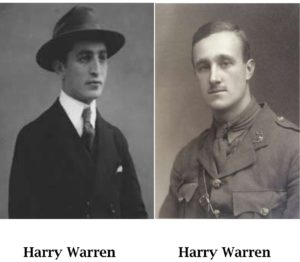
I never had composition lessons. At school, doing O-Level and A level music I did the harmony exercises, and got consistently good grades, but no-one ever told me how to take an idea of my own and develop it.
On one occasion I managed to string together about four or five fairly sophisticated chords (from my brother’s jazz guitar chords book) and to write a little melody over them. I showed it to my music teacher at school who was very enthusiastic, and told me to go off and write some more like that. I tried hard, but wasn’t able to take that idea any further. I didn’t have the tools, so it just ended there. If I remember rightly this was my little creation.

If only he’d said something like “Take this motif here and try putting it in a sequence – try to do something with this chord movement – try to write a reply to this melodic motif”. Or even just “Get to eight bars and then do it again!” But he didn’t. I suppose it just wasn’t his job.
When I look at compositions by high school students today (examining in the 21st century) I see almost the opposite. The emphasis has been placed on developing creativity, but quite often this is at the expense of learning the mechanics.
My early compositions, apart from some not very successful attempts at writing orchestral pieces, were all short little themes for the first jazz groups and jazz-rock groups I played with, from my last years at school through University. During these years I was still getting harmony and counterpoint lessons and scoring good marks, but no ”composition” teaching.
OK, in my second year at University there was the option of doing composition, and I didn’t take it. By now I was getting heavily into doing my jazz pieces, and was possibly developing a bit of a “jazzer” attitude and I knew this would not have gone down well with the teacher who taught composition. I was also, quite possibly, by this time, developing an “I can work it out for myself” attitude- not always a good idea –but i was young. There were no easily available “teach yourself composition” books, no internet tutorials. I had obtained a book on Webern and devoured it – I was actually quite good with serialism , but still the ability to take ideas much further eluded me- and Webern was hardly a good model for anyone wanting to write pieces longer than a couple of minutes.
So I got to the point where, at the age of 22, my music was being played on BBC national radio jazz programmes but I had difficulty composing anything longer than about 32 bars, (usually less) . Once the material was played we did solos, and then played the theme again at the end. Many jazz musicians have been content with this for all their lives.
My first ever broadcast piece was “Somebody Gave Me This Number”, written for the trio Isogon with Roger Dean on bass and Ashley Brown on drums. . Essentially I had written 12 bars of theme for alto sax and given the bass payer some rather vague ideas about what to do in accompaniment, (there were some chord symbols but I’ve lost them.) and the drummer was more than capable of working around the theme. The “head” is played twice, then 8 bars bass solo for the classical “middle eight” , then the head again. Then we improvised.
Here’s the lead sheet.

And here we are.
Fresh out of university I was starting to get quite good at structuring jazz pieces, and I gradually put together an original repertoire for my own quartet; pieces mostly lasting about 5 minutes combining themes, solos and obbligato passages, but actual compositions excluding improvisation, longer than a couple of minutes minute were still a problem I wanted to resolve.
In 1983 I had the fortune to be awarded an Arts Council bursary to write an extended work for my jazz Quartet. The length of the piece was more or less decided by the fact that I could most likely get it Broadcast on the Radio 3 jazz programme, and this was about 25 minutes. Jazz pieces of this length often tend to episodic, a sort of suite that segues from one section to the next. In fact I conceived the work in three sections: an opening theme with solos, a central section built around a percussion solo and a final theme with solos, that partly recalled the first section. I was living in a high-rise Block in Tower Hamlets when the Award came through, and I called the piece “Other Storeys” – a bit of play on words referring to the storeys of the block (we were half way up on the tenth floor), and literary collections- So-and-so and Other Stories (Not that I read books or anything). Anyway, I effectively confronted the length problem, on this occasion, by combining sections which were in some way motivically related. Maybe I was making progress…
Of course I had studied all the forms, what I still lacked was just the craft of effectively developing my ideas, but this didn’t stop me sending my compositions to publishers. Usually these were short chamber pieces: trios and quartets for flutes and saxophones- instruments I was confident about writing for. Inevitably they came back with nice little rejection slips. Then I had the idea, that as well as sending the music I could send a list of other compositions I had written , so if by chance, they were interested in anything else on the list, they might ask to look at that.
So it was that one publisher, having rejected a wind quintet, asked to see my Ten Studies for Flute. The only problem was, I hadn’t actually written ten studies for flute. This was 1985. I remember that because it was quite a good year for me all round. I was travelling abroad with Graham Collier’s band, had just started teaching a few jazz lessons at the Royal Academy, and had my first foreign tour with my own quartet. We were going to Hungary, sponsored by the British Council, to play the Debrecen jazz Festival and a concert in Budapest. So, I got my partner to write back to the publisher saying that Mr Warren was away on tour (I wasn’t at that time) and would send the Ten Studies for Flute as soon as he returned, Then I got down to writing them.
It’s often good to have a clearly defined task in hand. I gave myself a couple of weeks to write the ten studies, treating it as a sort of commission with a deadline. I decided to make them of medium difficulty. and I jotted down a list of the elements I wanted to feature: whole tone and diminished scales, fourth chord arpeggios . some time signature changes and so on, Then I just took my flute in hand and started work. They came quite easily to me, being short pieces, a couple of pages per study. Many of the opening motifs were directly improvised on the flute and then written down, and then, to a limited extent…developed.
I wrote them out as tidily as I could (no computers in those days) and sent them off. They were accepted. This was of course fantastic! I finally had something published by a mainstream publisher, Stainer & Bell, who would print the books and distribute them. The euphoria lasted about six months. There was a brief initial period when my book of studies (picture below) was actually present in music shops all over London. But the studies weren’t on anybody’s exam syllabus so apart from a few curiosity sales nothing really happened; the few copies present in the shops gradually got sold, and it seems no re-orders were made. The few complementary copies I received were sent out to friends and colleagues who I thought might be interested, and that was that. The Studies have just sat in the Stainer & Bell catalogue all these years (35 at the time of writing.) I could hardly expect a massive sales push, but still this was disappointing, and I found myself asking . “Well, why did they bother to publish them?”
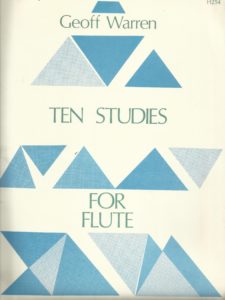
Further disappointment came with the total lack of any change in my relationship with the publisher. The rejection slips remained impersonal. and at no time did they approach me saying they were looking around for a certain type of material. There was, in fact, no relationship. One book of mine just happened to be in their catalogue.
Looking back today at the Ten Studies of 1985, I can see that they were quite a bit better than anything else I was writing at the time. Just a fluke? Or maybe having the task in front of me to focus my thinking, and having to work only with my first instrument, on some pieces which would all be quite short: -the conditions couldn’t have been more favourable.
Recently the studies have disappeared from the S&B website and are only available on request in PDF. I am working on getting a new edition available. Since 1985 my profile as a flautist has grown from where it was then (nowhere) to where it is now (somewhere) so it would make sense for them to be available again.
In one of Frank Zappa’s books he advises aspiring musicians to set up their own publishing company. The logic being: record sales royalties pay only after costs have been recovered by the record company, whereas publishing royalties pay from the start. I was not chasing a record deal as a rock artist but a couple of my friends had publishing companies that practically existed only on paper. This gave them more control of their material and on some occasions, performance and broadcast royalties were greater than for unpublished works.
As I was getting occasional radio play of things I was doing, and was also sending around a lot of cassettes, I thought having a publishing company might be a good idea. I was also told the investment required was not great (at that time.) So, I called the MPA, Music Publishers Association, in London, and asked if they had any leaflets giving guidelines on getting set up. Yes, I was told and they took my address and promised to mail me.
What arrived two days later was both weird and disappointing. They had posted me a leaflet saying (paraphrasing, but not much) “We understand you are thinking of setting up your own publishing company, our advice is – don’t! ” They had actually spent the time putting this in an envelope and stamping it and sending it to me. It went on to say how I would be much better served offering my music to one of their many member publishers rather than trying to do it for myself. It just hadn’t occurred to them that I was wanting to set up my own company exactly because there was no way my jazz pieces were going to get taken up by one of their wonderful member publishers. I am still amazed by this episode. – that they had actually gone to the lengths of printing a leaflet advising me what NOT to do.
Still, as a deterrent it must have worked because I lost interest in the idea.
I have come across various kinds of publishers in my life. Firstly, those, “old school” or “real” publishers who print books and try to get them into shops and, these days. sell on-line of course.. To these publishers I have generally offered my chamber works.
Then there have been the publishers who, because they are part of a record company, take 50% of royalties of the pieces that go on a record but are not interested in marketing any printed copy, In the jazz sector many independent record labels have depended heavily on publishing to finance their operations, relying on the fact that the groups would go around performing the material they had recorded, and performance royalties would come back, not only to the musicians, but also to the record company.
Then there have been those who produce manuals, such as “teach yourself” books, not interested in performance royalties on the music as such, just in shifting books by the lorryload. I wrote (and co-wrote) three such books and in each case created a lot of material –short educational pieces, and always the publisher was not interested in the copyright of the actual music, they just needed my permission to use it. They were perhaps more a printer and distributer than a publisher.
The advent of computers made a big difference. At first. Like many, I was diffident, but I eventually bit the bullet and got a desktop, (which took up more than half the desk.) Shortly after, a friend handed me a floppy disc with a little music publishing programme , Encore.3 . It wouldn’t be much of an exaggeration to say this changed my life. After the inevitable teething period, with various phone calls to my benefactor asking how to do this or that, I started to get the hang of the programme and even became a bit of an expert.
As a first task I set myself, I got all my old compositions from fading photocopies of hand written manuscript onto Encore files. Quite a big task, but I just took one piece (quite often a little jazz tune ) a day, and during this process perfected my skills with the programme.
The big change was being able to transpose sections quickly and copy and paste them where I wanted. This eased the stress on my brain, which had had to remember what I was doing while copying by hand and transposing mentally. Although, It should be said I’ve never been much of a literal copier and paster, I always come back to make adjustments such as tidying up voicings.
The other big change was having an instant playback. My piano skills have never been up to reproducing scores, even just quartets, so having the modest midi audio helped me greatly. I have lived many periods of my life without a keyboard in the house, and am convinced that some of my compositions have even benefited from my thinking out chord progressions in my head rather than writing what was readily under my hands at the keyboard. (Nobody Phoned is case in point,) still, being able to hear back immediately what I had just written was a great advantage.
Stravinsky divided his creative process into two phases;: the sitting-in-the-garden-with-a-sketch-book phase, during which he jotted down little melodic fragments, and the working-it-out phase, during which he sat at the piano and combined and developed his ideas. My first phase has often been with an instrument in my hand- a little motif arises- seems almost to come out of your hands, and you quickly scribble it down, maybe taking it up to 8 or 16 bars with a mixture of improvisation and logical development, but relying heavily on instinct and sheer impetus to get over any block. Sometimes my first idea might come while walking (walking has always been a great stimulant to my mental processes,) and fortunately , my analytical skills allow me to “write down” what I hear in my head and have also a visual memory of it. Now with the computer my second phase was more assured with the possibility of sticking sections together and seeing and hearing how they worked.
At this time (late ‘nineties) I was living in North Italy and teaching a lot in the private sector. My students were saxophonists and flautists, mostly with no professional aspirations, and we worked on “modern” material – jazz, rock and pop. Playalong CDs were becoming all the rage and it made sense for me to create some material which would then be packaged and sold internally by the schools I was working for. So I wrote six pieces for saxophone and playalong CD (with the sounds of a full band accompanying), and six pieces for flute with piano accompaniment only on the track, since I was hoping one day to get these accepted by a “real” publisher who would want a piano part too.
The “Sei Pezzi per Flauto e Pianoforte” were written between 1998 and 2000. I struggled a little with the piano parts, working my basic “strumming” piano style into something a little more pianistic, and I had the final version checked by a “real” pianist. (Something I continue to do to this day when writing for piano) . The first “Edition” was an internal production by the M.A.T. Music School in Verona where I was Artistic Director for many years, and with the help of producer Clemente Bonati (who also was to produce two of my CDs –Frammenti d’Anima and The Quartet Album.) About ten years later I managed to place them with Italian publisher Casa Musicale Eco and they have been amongst my most successful publications. They are fairly accessible, and difficulties arising are usually rhythmic rather than technical. It also seems they are fun to play.
The six pieces for saxophone had a fuller sounding accompaniment –perhaps more exciting to listen to, but excluding the possibility of providing a piano version. Working with Clemente, we enjoyed ourselves finding samples of vintage keyboards and guitar effects.
Here is one of them, “Country Lives”. It uses a 4+4+2 rhythmic cycle which I borrowed from Indian music.
Having had some success with the flute and piano pieces, and almost convincing myself I could now write for piano I decided to take things further and write something a little more challenging, but keeping more or less to the style I had established with the “Sei Pezzi” .that is- tonal (or modal) using a mixture of “classical “and jazz Fusion” harmony , avoiding chains of jazzy sevenths, sometimes preferring quartal solutions and often resolving to a simple major triad at the ends of phrases. I wanted a palette that had all the possibilities of jazz and fusion with some classical “modernity” to it, combined with my usual rhythmic eccentricities (inherited from the Canterbury School) for which, by now I was known.
So I embarked on the project which was to be a suite for flute and piano: four pieces which could be performed together or independently, with some optional improvised passages (solos also provided). The first to be finished was the “Entrata” and I managed to get this published by a small publisher in North Italy, who some years later, on closing shop, released the work, enabling me to place it with Forton Music in England.
Here is the opening.
I made contact with UK publisher Forton Music in 2012, and as well as taking on Entrata” they invited me to propose other works. Forton are a wind music publisher and they travel around setting up stands at the various wind instrument festivals. They are real musicians living in a real world and are the publisher I was always looking for. In the years that followed I have developed my flute and flute ensemble catalogue with them, and now living in Pescara have managed to form a flute quartet, Fluticity, with two professors from the Conservatoire, Lorenza Summonte and Gabriele Di Iorio and my wife Marzia Del Biondo , giving me the possibility to experiment, and to develop and present this repertoire. So I have written duets, trios quartets and flute choir pieces. Possibly the most successful of all these works has been the collection of duets for Flute and Alto Flute “Wild Berries”.

Of course, not everything you write ends up getting published. In fact most of it doesn’t- unless you’re a big name and somebody wants you in exclusive so they jealously hang on to every little scribble.. In recent years, my activity as a jazz flute workshop leader has prompted me to develop a repertoire of pieces for flutes (and sometimes other wind instruments) with backing tracks. Some of my personal favourite compositions of recent years have been for this format, which unfortunately is not the sort of thing a publisher can easily market. Flute choirs tend to be just that, an ensemble of lots of flutes of different sizes, and are generally not used to, or inclined to, working with backing tracks. Yet i have found, travelling across various countries, that this solution is very presentable and adaptable. I just need some speakers and a way of putting my audio files though them.
Here I am in Norway doing a workshop with a hundred or so young people, playing (mostly) with my backing tracks though a PA.
Larger projects along the way have included my Concerto , which I talked about previously in this blog, and a Musical, Poker, written with Ruth Sharon Koch and produced in Germany in 1993. I have noticed, getting older, that I am less inclined to write without an objective – a project. Ideas may turn up and they will be duly annotated, maybe taken as far as 8 or 16 bars and then filed away, sometimes to be fished out at a later date, sometimes just to stay in the folder, but it’s more likely that I will think of what I want to write before I write it.
Uncategorized: Accademia Flauto jazz blues flute Borrello diploma in flauto jazz flauto jazz flute fables FMR Records Forton Music free sheet music downloads funky funky jazz funky jazz geoff warren Geoff Warren Quartet groove improvised indo jazz jazz jazz education jazz flute jazz flute summer school jazz flutemusic LAUREA IN FLAUTO JAZZ MatRecords Online lessons skype jazz flute lessons TUTU Records yamaha
by admin
leave a comment
Uncategorized: blues flute Borrello diploma in flauto jazz ethno-jazz flute fables FMR Records free sheet music downloads funky funky funky jazz funky jazz Geoff Warren Quartet groove improvised indo jazz jazz jazz flute Jazz flute music jazz flute summer school jazz flutemusic LAUREA IN FLAUTO JAZZ MatRecords nu jazz skype jazz flute lessons TUTU Records yamaha
by admin
leave a comment
Uncategorized: blues flute Dan Banks diploma in flauto jazz ethno-jazz fire music flauto jazz flute fables FMR Records funky jazz jazz flute Jazz flute music jazz flute summer school jazz flutemusic Jose Canha MatRecords Online lessons Trevor Taylor TUTU Records yamaha
by admin
leave a comment
Uncategorized: BBC Radio blues flute diploma in flauto jazz flute fables FMR Records free sheet music downloads funky funky jazz geoff warren Geoff Warren Quartet Graham Collier groove improvised jazz jazz education Jazz flute music jazz flute summer school jazz flutemusic La Côte Flûte Festival LAUREA IN FLAUTO JAZZ MatRecords reisser musik skype jazz flute lessons TUTU Records yamaha
by admin
leave a comment
Uncategorized: British Flute Society diploma in flauto jazz ethno-jazz flauto jazz flute fables Flute quartet fluticity FMR Records Forton Music free sheet music downloads funky funky funky jazz funky jazz gabriele di iorio geoff warren Geoff Warren Quartet groove improvised jazz flute Jazz flute music jazz flute summer school jazz flutemusic La Côte Flûte Festival lorenza summonte marzia del biondo MatRecords skype jazz flute lessons yamaha
by admin
leave a comment
Uncategorized: blues flute Borrello corso estivo in flauto jazz diploma in flauto jazz flauto jazz flute fables FMR Records funky funky jazz funky jazz geoff warren Geoff Warren Quartet groove improvised indo jazz jazz jazz education jazz flute Jazz flute music jazz flute summer school jazz flutemusic LAUREA IN FLAUTO JAZZ Marco Di Marzio MatRecords raffaele pallozzi skype jazz flute lessons TUTU Records yamaha
by admin
leave a comment
Uncategorized: blues flute Borrello Bournemouth British Flute Society diploma in flauto jazz ethno-jazz flauto jazz flute fables FMR Records free sheet music downloads funky funky jazz funky jazz geoff warren groove jazz education jazz flute jazz flute summer school jazz flutemusic LAUREA IN FLAUTO JAZZ MatRecords Simon Purcell Steve Street Trevor Taylor TUTU Records yamaha
by admin
leave a comment
Uncategorized: blues flute Borrello corso estivo in flauto jazz diploma in flauto jazz ethno-jazz flauto jazz flute fables FMR Records Forton Music free sheet music downloads funky funky jazz funky jazz geoff warren groove improvised jazz education jazz flute Jazz flute music jazz flute summer school jazz flutemusic LAUREA IN FLAUTO JAZZ MatRecords Online lessons skype jazz flute lessons TUTU Records yamaha
by admin
leave a comment
Uncategorized: afro jazz blues flute Budapest Flute Academy diploma in flauto jazz ethno-jazz flauto jazz flute fables FMR Records Forton Music free sheet music downloads funky funky funky jazz geoff warren Geoff Warren Quartet jazz education jazz flute Jazz flute music jazz flute summer school LAUREA IN FLAUTO JAZZ MatRecords Online lessons TUTU Records yamaha
by admin
leave a comment
